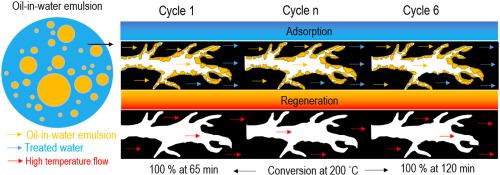Microporous and Mesoporous Materials ( IF 4.8 ) Pub Date : 2021-09-09 , DOI: 10.1016/j.micromeso.2021.111424 Oscar E. Medina 1, 2 , Dahiana Galeano-Caro 1 , Raúl Ocampo-Pérez 3 , Agustín F. Perez-Cadenas 2 , Francisco Carrasco-Marín 2 , Camilo A. Franco 1 , Farid B. Corteś 1

|
This study aims to evaluate the reuse capacity of carbon xerogels-Ce/Ni composite (XCeNi) during crude oil adsorption from O/W emulsions and subsequent regeneration through the oxidation process using air as an oxidant agent for six cycles. For the six cycles of evaluation, batch adsorption experiments were done at different temperatures and modeled using the solid-equilibrium model (SLE). In contrast, catalytic tests were performed under non-isothermal and isothermal heating. To estimate the change in the sample's surface composition, X-ray photoelectron spectroscopy (XPS) analysis was carried out during each regeneration cycle. According to batch adsorption experiments and SLE fitting, the XCeNi sample presents a high affinity for hydrocarbons and a similar maximum adsorption capacity during six regeneration cycles. Crude oil was also successfully decomposed under non-isothermal heating (100–800 °C), reducing the main decomposition peak from 250 to 150 °C for all the evaluated cycles. Under isothermal heating at 150, 200, and 250 °C, conversions of 100% were obtained for all cycles evaluated. At the first cycle the time required to decompose 100% of adsorbed crude oil at 60 min, whereas, after the 6 cycle, it is achieved at 120 min. The gaseous analysis of the products involved in the oxidation of the crude oil in each cycle was considered, finding an increase in the production of light hydrocarbons and reducing gas emissions such as CO2, NOX, and SOX during all reuses. The activation energy increases from 10.1 to 18.7 kJ mol−1 during the six cycles due to the reduction of the content of Ce3+. The Ce3+ concentration is reduced to 0 after each adsorption cycle. Apparently, the ability of the xerogel to decompose the adsorbed crude during all cycles may be associated with the increase in Ce3+ during the adsorption process, and then during the oxidation treatment is transformed to Ce(OH)22+. Also, the influence of Ni2+ on XCeNi is noted. Through the regeneration, the Ni2+/Ni3+ ratio varies, which shows the continuous redox processes that have taken place in this sample.
中文翻译:

开发用于从盐水包油乳液中去除原油的整体碳干凝胶-金属复合材料:再利用循环评估
本研究旨在评估碳干凝胶-Ce/Ni 复合材料(XCeNi)在从 O/W 乳液中吸附原油以及随后通过使用空气作为氧化剂进行六次循环的氧化过程再生过程中的再利用能力。对于六个评估循环,在不同温度下进行批量吸附实验,并使用固体平衡模型 (SLE) 进行建模。相比之下,催化测试是在非-等温和等温加热。为了估计样品表面成分的变化,在每个再生周期中进行了 X 射线光电子能谱 (XPS) 分析。根据批量吸附实验和 SLE 拟合,XCeNi 样品在六个再生循环中表现出对碳氢化合物的高亲和力和相似的最大吸附容量。原油在非等温加热(100-800°C)下也成功分解,将所有评估循环的主要分解峰从 250°C 降低到 150°C。在 150、200 和 250 °C 的等温加热下,所有评估循环的转化率均达到 100%。在第一个循环中,在 60 分钟时分解 100% 吸附的原油所需的时间,而在第 6 个循环后,分解时间为 120 分钟。2、NO X和SO X在所有再利用期间。由于Ce 3+含量的减少,在六个循环期间活化能从10.1 增加到18.7 kJ mol -1。在每个吸附循环后,Ce 3+浓度降低到0。显然,干凝胶在所有循环中分解吸附原油的能力可能与吸附过程中Ce 3+的增加有关,然后在氧化处理过程中转化为Ce(OH) 2 2+。此外,还注意到Ni 2+对 XCeNi的影响。通过再生,Ni 2+ /Ni 3+ 比率变化,这表明在该样品中发生了连续的氧化还原过程。











































 京公网安备 11010802027423号
京公网安备 11010802027423号